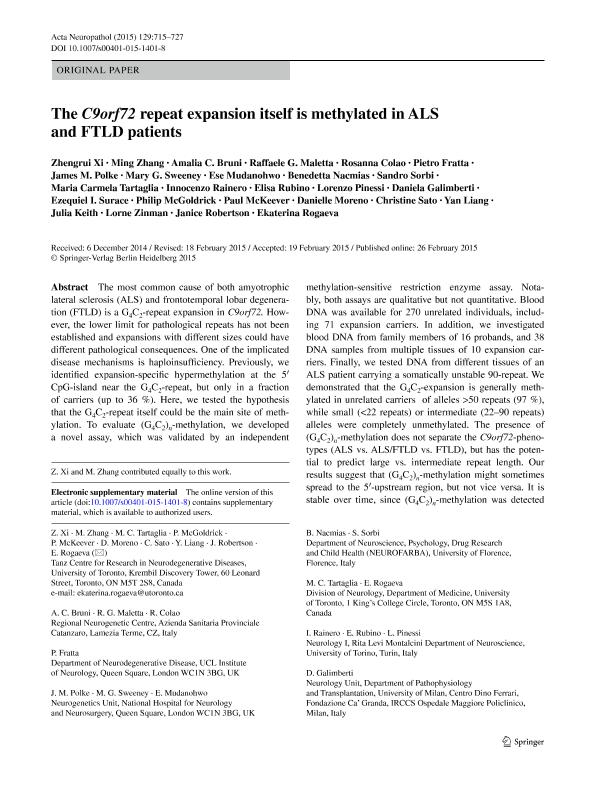Artículo
The C9orf72 repeat expansion itself is methylated in ALS and FTLD patients.
Xi, Zhengrui; Zhang, Ming; Bruni, Amalia C.; Maletta, Raffaele G.; Colao, Rosanna; Fratta, Pietro; Polke, James M.; Sweeny, Mary G.; Mudanohwo, Ese; Nacmias, Benedetta; Sorbi, Sandro; Tartaglia, Maria Carmela; Rainero, Innocenzo; Rubino, Elisa; Pinessi, Lorenzo; Galimberti, Daniela; Surace, Ezequiel Ignacio ; McGoldrick, Philip; McKeever, Paul; Moreno, Danielle; Sato, Christine; Liang, Yan; Keith, Julia; Zinman, Lorne; Robertson, Janice; Rogaeva, Ekaterina
; McGoldrick, Philip; McKeever, Paul; Moreno, Danielle; Sato, Christine; Liang, Yan; Keith, Julia; Zinman, Lorne; Robertson, Janice; Rogaeva, Ekaterina
 ; McGoldrick, Philip; McKeever, Paul; Moreno, Danielle; Sato, Christine; Liang, Yan; Keith, Julia; Zinman, Lorne; Robertson, Janice; Rogaeva, Ekaterina
; McGoldrick, Philip; McKeever, Paul; Moreno, Danielle; Sato, Christine; Liang, Yan; Keith, Julia; Zinman, Lorne; Robertson, Janice; Rogaeva, Ekaterina
Fecha de publicación:
05/2015
Editorial:
Springer
Revista:
Acta Neuropathologica
ISSN:
0001-6322
Idioma:
Inglés
Tipo de recurso:
Artículo publicado
Clasificación temática:
Resumen
The most common cause of both amyotrophic lateral sclerosis (ALS) and frontotemporal lobar degeneration (FTLD) is a G4C2-repeat expansion in C9orf72. However, the lower limit for pathological repeats has not been established and expansions with different sizes could have different pathological consequences. One of the implicated disease mechanisms is haploinsufficiency. Previously, we identified expansion-specific hypermethylation at the 5´ CpG-island near the G4C2-repeat, but only in a fraction of carriers (up to 36 %). Here, we tested the hypothesis that the G4C2-repeat itself could be the main site of methylation. To evaluate (G4C2) n -methylation, we developed a novel assay, which was validated by an independent methylation-sensitive restriction enzyme assay. Notably, both assays are qualitative but not quantitative. Blood DNA was available for 270 unrelated individuals, including 71 expansion carriers. In addition, we investigated blood DNA from family members of 16 probands, and 38 DNA samples from multiple tissues of 10 expansion carriers. Finally, we tested DNA from different tissues of an ALS patient carrying a somatically unstable 90-repeat. We demonstrated that the G4C2-expansion is generally methylated in unrelated carriers of alleles >50 repeats (97 %), while small (<22 repeats) or intermediate (22-90 repeats) alleles were completely unmethylated. The presence of (G4C2) n -methylation does not separate the C9orf72-phenotypes (ALS vs. ALS/FTLD vs. FTLD), but has the potential to predict large vs. intermediate repeat length. Our results suggest that (G4C2) n -methylation might sometimes spread to the 5´-upstream region, but not vice versa. It is stable over time, since (G4C2) n -methylation was detected in carriers with a wide range of ages (24-74 years). It was identified in both blood and brain tissues for the same individual, implying its potential use as a biomarker. Furthermore, our findings may open up new perspectives for studying disease mechanisms, such as determining whether methylated and unmethylated repeats have the same ability to form a G-quadruplex configuration.
Palabras clave:
ALS
,
FTD
,
C9ORF72
,
METHYLATION
Archivos asociados
Licencia
Identificadores
Colecciones
Articulos(SEDE CENTRAL)
Articulos de SEDE CENTRAL
Articulos de SEDE CENTRAL
Citación
Xi, Zhengrui; Zhang, Ming; Bruni, Amalia C.; Maletta, Raffaele G.; Colao, Rosanna; et al.; The C9orf72 repeat expansion itself is methylated in ALS and FTLD patients.; Springer; Acta Neuropathologica; 5-2015; 1-13
Compartir
Altmétricas



